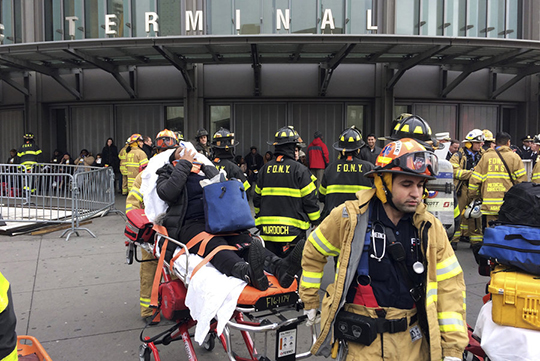New York, Jan 5: A New York commuter train derailed Wednesday during the morning rush at a station in Brooklyn, leaving more than 100 people with mostly minor injuries and sparking travel delays, officials said.

The accident at Atlantic Terminal in the heart of the New York borough comes less than four months after a fatal crash on another commuter line in New Jersey, when a train derailed as it entered a station.
On Wednesday, a Long Island Rail Road train crashed around 8:30 am (1330 GMT).
Passengers rushed out as smoke filled the tunnel. The impact bent the train's doors and smashed windows.
Some of the injured were brought out on stretchers.
Officials -- visibly relieved the toll was not higher -- said they were launching an investigation.
"103 injuries reported at scene of Atlantic Terminal LIRR train derailment, all non-life-threatening," the New York Fire Department said in a tweet.
A fire department official said the train carried 500 to 600 people, and the first two train cars were seriously damaged.
"We were lucky, it could have been quite a bit worse," the official said.
At least 11 people were taken to hospital, and were unable to walk, he added.
New York Governor Andrew Cuomo explained that the train was supposed to stop at a bumper but failed to do so, moving a few feet past it. He said the most serious injury was a possible broken leg.
"First concern is (for) the people on the train. There were a number of minor injuries," he told reporters.
"What happened with the operator, we don't know. And obviously there will be an investigation to find out exactly what happened, why the operator didn't stop the train before it hit the bumper block."
Explaining why it was difficult to pinpoint exactly how many people were injured, Cuomo added: "They were standing and they were getting ready to get off the train.
"The train has a sudden stop, they're not prepared for the sudden stop. They get knocked around, banged around, they hurt an arm, they hurt a leg."
Commuter Aaron Neufeld said on Twitter that the crash was "crazy," but added, "Seems only a few people are lightly injured."
New York's emergency notification system warned of traffic and transit delays and road closures in the area.
In September, a train derailed during rush hour as it entered the station in Hoboken, New Jersey. One person died and 114 were injured.
An investigation into that incident, in which the train entered the station at an unusually high speed, is ongoing.





Comments
Add new comment